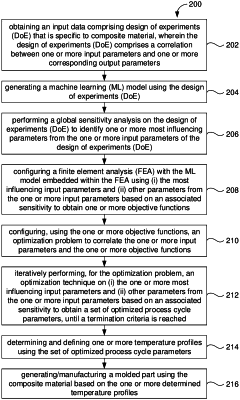| CPC G06F 30/23 (2020.01) [G06F 30/27 (2020.01); G06N 20/00 (2019.01); G06T 17/20 (2013.01); G06F 2113/26 (2020.01); G06F 2119/18 (2020.01)] | 12 Claims |

|
1. A processor implemented simulation method for manufacturing molded parts using composite materials, comprising:
obtaining one or more input parameters through design of experiments (DoE) that is specific to a composite material made of a fibre reinforcement embedded with a polymer material, wherein the design of experiments (DoE) comprises a correlation between the one or more input parameters and one or more corresponding output parameters;
generating a machine learning (ML) model using the design of experiments (DoE);
performing a global sensitivity analysis on the design of experiments (DoE) to identify one or more most influencing parameters from the one or more input parameters of the design of experiments, wherein the most influencing input parameters comprises at least one of dwell temperature and dwell time;
configuring a finite element analysis (FEA) with the ML model embedded within the FEA for material modeling using (i) the most influencing input parameters and (ii) other parameters from the one or more input parameters based on an associated sensitivity to derive one or more output variables, wherein one or more objective functions are determined from the one or more output variables, wherein the associated sensitivity of the one or more input parameters is derived by ranking of the one or more input parameters based on a correlation coefficient value obtained by the global sensitivity analysis, and wherein the other parameters m rises at least one of a heating rate, a cooling rate, a number of sampling points, and a sampling method;
configuring, using the one or more objective functions, an optimization problem to correlate the one or more input parameters and the one or more objective functions;
iteratively performing, for the optimization problem, an optimization technique on (i) the one or more most influencing input parameters and (ii) other parameters from the one or more input parameters based on the associated sensitivity to obtain a set of optimized process cycle parameters, until a termination criterion is reached, wherein one or more geometrical constraints of a molded part to be manufactured using the composite material is used in the optimization technique such that the molded part is divided into a plurality of zones based on the one or more geometrical constraints and the optimization technique is performed individually for each zone of the plurality of zones of the molded part for optimizing (i) the one or more most influencing input parameters and (ii) the other parameters from the one or more input parameters;
determining and defining one or more temperature profiles using the set of optimized process cycle parameters, wherein the one or more determined temperature profiles comprises at least cure temperature cycle information corresponding to each zone of the plurality of zones of the molded part;
transferring the one or more determined temperature profiles to a master controller for the manufacturing of the molded part and controlling a plurality of controllers by the master controller, each of the plurality of controllers controlling one or more control parameters of at least one zone of the plurality of zones of the molded part; and
manufacturing the molded part, by the master controller, using the composite material based on the one or more determined temperature profiles.
|